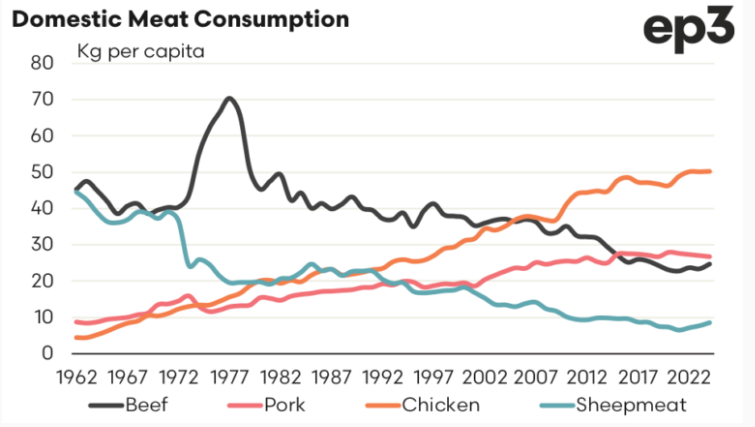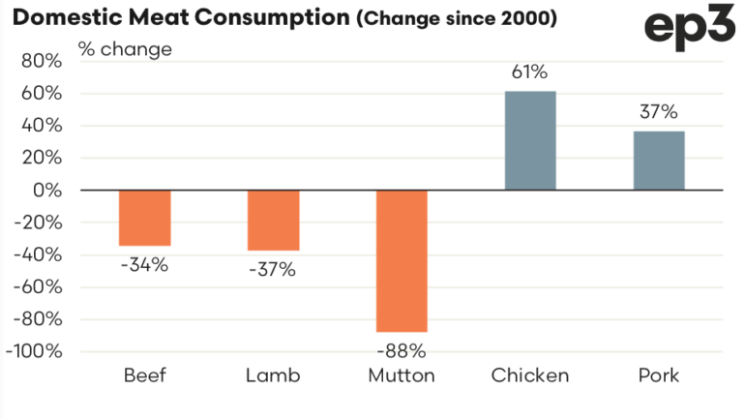Over the past six decades, Australians’ meat-eating habits have significantly evolved, reflecting wider economic, social, and cultural shifts. From the cattle market collapse that drastically altered beef consumption to the steady rise of chicken and pork, Australia’s dietary patterns provide insight into a nation adjusting to new realities.
The data from the 1960s onwards marks the beginning of a noticeable trend in annual per capita meat consumption. A spike in beef intake in the 1970s stands out conspicuously, correlating with the collapse of the Australian cattle market during this period. Beef, abundant and inexpensive, became a staple on Australian dinner tables. This surge, however, had a knock-on effect, displacing other meats, particularly sheep meat, whose consumption dipped as a consequence.
But this beef bonanza was short-lived. By the 1980s, a steady decline in red meat consumption commenced. Various factors contributed to this shift, including economic downturns, health recommendations advocating for reduced red meat intake, and the public’s growing concerns about environmental sustainability and food affordability.
As red meat took a back seat, poultry and pork began to cluck and oink their way to prominence. Chicken, once a luxury, transformed into the meat of the masses. Its affordability, perceived health benefits, and versatility made it the darling of the Australian kitchen. Pork, too, found favour, with its lower cost and fat content compared to red meats, emerging as a popular alternative.
Despite attempts to rekindle Australians’ love affair with sheep meat, including the 1990s memorable campaign forcing a choice between a lamb roast meal at home with the option of dinner with Tom Cruise, consumption continued to languish. The advert’s humour and patriotism didn’t translate into a sustained increase in demand. Why did the campaign not resonate enough to spike sheep meat consumption numbers?

Since the growth in sheep meat export markets in the early 2000s saw a significant decline in the per capita volume of mutton consumption in Australia. Indeed, from 2000 to 2024 per capita mutton consumption has eased by 88%. Beef and lamb have also seen a reduction in consumption, on a per capita basis, by 34% and 37% respectively over the same time frame.
The poultry and pork sectors have been the beneficiaries of the changing Australian palate with per capita increases of 61% for chicken and 37% for pork since 2000.

One reason for the decline in red meat consumption levels might be the changing demographics of Australia. With a more multicultural society, dietary habits diversified. The cuisines of Asia, India and the Middle East, which tend to favour chicken and red meat differently, influenced local palates. Furthermore, the economic factors that made chicken and pork attractive alternatives, such as a lower cost point and growing availability, continued to overshadow red meat.
Pork and chicken benefited not just from their economic advantages, but also from changing consumer perceptions. The health-conscious consumer perceived white meats as leaner and more diet-friendly, aligning with the rising fitness culture. Additionally, the ease of cooking and shorter preparation time of these meats catered to the fast-paced lifestyle of modern Australia.
Innovation in poultry and pork production, with advances in breeding, feeding, and processing, led to increased efficiency and lower retail meat prices versus the red meat options. The market responded to these meats’ versatility and adaptability in an era where convenience is king. Additionally, the growth in sheep meat exports throughout the 2000 – 2020 period saw the offshore consumer prepared to pay a higher value for Australian sheep meat than the domestic consumer, particularly for mutton, driving sheep meat product to overseas destinations.
Environmental concerns also play a role in shaping consumption trends. Red meats, particularly beef, are perceived by many consumers to have higher greenhouse gas emissions and resource use requirements. This environmental consideration has swayed some consumers towards poultry and pork, perceived (rightly or wrongly) to be more sustainable choices.
The landscape of meat consumption in Australia is a testament to a dynamic interplay of economic forces, social changes, health considerations, and environmental concerns. While beef and sheep meat consumption has waned, chicken and pork have soared, filling the plates and preferences of a nation in flux. The challenge for the sheep meat industry remains significant. It must navigate a complex web of factors to reclaim its place at the Australian table, a challenge that calls for innovation and adaptability in equal measure.
As Australia looks forward, its meat consumption patterns will likely continue to evolve, reflecting the nation’s ongoing negotiation with its values, resources, and role in a rapidly changing global context.
Subscribe to our weekly newsletter and monthly cattle, sheep, and machinery round-ups.